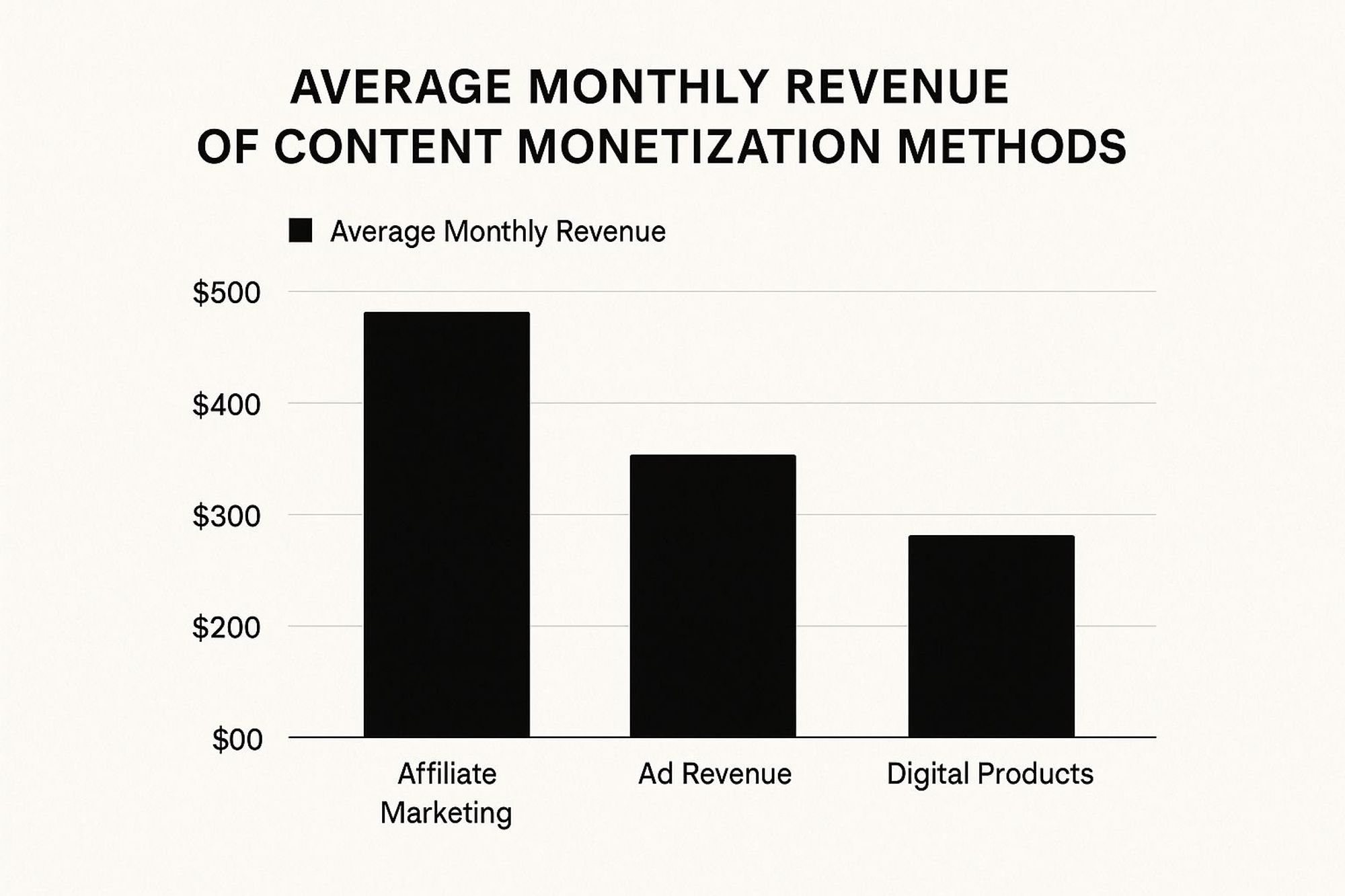Sunday, July 20, 2025
How to Monetize Content: Proven Strategies to Earn More


Turning your creative passion into a real, sustainable paycheck can feel like a huge mountain to climb, but it's more within reach than ever. The secret to figuring out how to monetize content isn't about chasing one viral hit. It's about building a multi-layered strategy that combines different income streams into a stable business.
Your Blueprint for Sustainable Creator Income
Let's be real for a second. The whole "overnight success" story is mostly a myth. Building a lasting business as a creator means having a solid roadmap. Forget the get-rich-quick nonsense; true sustainability comes from setting up several revenue pillars that all support each other. This approach gives you stability, so a bad month in one area doesn't bring down your whole operation.
This isn't just wishful thinking—it's backed by a massive economic shift. The global digital content creation market was valued at a staggering $27.1 billion in 2023. And it's not slowing down. Projections show it rocketing to $43.9 billion by 2027, which just goes to show the incredible opportunity waiting for creators who approach their work like a real business.
The Four Pillars of Content Monetization
Most successful monetization strategies are built on four core pillars. Once you understand how they work together, you're on your way to building a solid financial foundation for your brand.
- Advertising Revenue: This is often the first stop for creators. You earn money from ads shown on your content, like on a YouTube channel or a blog.
- Affiliate Partnerships: Here, you promote products or services you genuinely use and trust. You get a commission for any sales made through your unique link.
- Direct Sales: This is where you sell your own stuff—digital or physical—directly to your audience. Think ebooks, custom templates, courses, or merchandise.
- Recurring Subscriptions: This model creates predictable, steady income through memberships or subscriptions, where you offer exclusive content or perks to your paying supporters.
The most resilient creators I know never put all their eggs in one basket. They expertly weave together 2-3 of these models to create a financial safety net. If ad rates dip one month, a successful product launch or strong affiliate commissions can easily pick up the slack.
The chart below gives you a clear picture of how these different monetization methods can perform, really driving home why a blended approach is almost always the smartest move.

As you can see, while something like affiliate marketing might bring in a higher average revenue on its own, combining it with ad revenue and your own digital products creates a much more diversified and stable income base.
To help you visualize how these models stack up, here's a quick comparison.
Key Content Monetization Models at a Glance
This table breaks down the four main monetization methods, giving you a sense of the effort involved, what you can realistically expect to earn, and which type of creator is the best fit for each.
| Monetization Model | Effort Level | Income Potential | Best For |
|---|---|---|---|
| Advertising Revenue | Low-Medium | Low-High | Creators with high traffic (blogs, YouTube channels). |
| Affiliate Partnerships | Medium | Medium-High | Niche experts with an engaged, trusting audience. |
| Direct Sales | High | High | Creators with specific expertise to package and sell. |
| Recurring Subscriptions | High | Medium-High | Community-builders who can offer continuous value. |
Looking at the table, it's clear there's no single "best" option—it all depends on your goals, your audience, and how much time you can invest. The real power comes from combining them.
Weaving Your Strategy Together
The real magic happens when these methods start working together. For instance, a blog post reviewing a product (affiliate marketing) can simultaneously generate ad revenue. In that same post, you can include a call-to-action that points readers to your own digital product, like a comprehensive guide or a set of templates that solves a related problem.
Of course, the platform you build on can massively impact your earning potential. If you're wondering which one might be best for you, check out our guide on what social media platform pays the most.
Your ultimate goal is to build an ecosystem where every piece of content can serve multiple monetization purposes. This blueprint isn’t just about making money. It's about building a durable business that can adapt to industry changes and grow right alongside you. For a wider look at different income streams, you might find these 8 Ways to Monetize Digital Content really insightful.
Mastering Ads and Affiliate Marketing

Let's talk about ads and affiliate links. Diving into these can feel a bit intimidating, and I get it. A lot of creators worry that they'll come across as a "sell-out" if they start running ads. But when you do it right, it’s one of the most reliable ways to earn a real income from your content.
The trick is to weave these revenue streams into your work so they feel natural and genuinely helpful, not like a pushy sales pitch. It’s about way more than just flipping a switch; true mastery comes from understanding what works for your brand and what your audience will actually appreciate.
Navigating the World of Ad Revenue
Advertising is usually the first stop for creators looking to monetize. It's mostly passive once you get it set up, but "passive" doesn't mean you can just set it and forget it. You need a strategy. You’ve really got two main paths here: programmatic ads and direct ad sales.
Programmatic Advertising
This is the route most people take, at least at first. You partner up with an ad network like Google AdSense, Mediavine, or Raptive, and they automatically place ads on your website or in your videos.
- Pros: It’s incredibly hands-off. The network finds the advertisers, places the ads, and handles the payments. This frees you up to do what you do best—create amazing content.
- Cons: You get less say in which ads show up, and your revenue per thousand impressions (RPM) can swing wildly depending on your traffic, niche, and even the time of year.
Direct Ad Sales
This is where you sell ad space directly to brands yourself. You'll need to create a media kit, figure out your rates, and start negotiating deals. It’s definitely more legwork, but the financial upside can be massive.
This is a fantastic strategy once you've built a strong, dedicated audience in a specific niche. For instance, if you're a food blogger with a loyal following, you could sell banner ad space directly to a kitchenware company. The payout is often 2-3x higher than what you'd get from programmatic networks for the exact same ad spot.
Key Takeaway: Kick things off with programmatic ads to get a baseline income flowing. As your audience and authority grow, put together a simple media kit and start reaching out to a few dream brands that are a perfect match for your followers.
The Art of Authentic Affiliate Marketing
Affiliate marketing isn't about spamming links and praying for clicks. At its core, it's about cashing in on the trust you've worked so hard to build with your community by recommending products and services you genuinely love. When you do it with care, it becomes an incredibly powerful way to monetize because it’s based on a real, authentic endorsement.
The sheer scale of digital advertising is mind-boggling. Global digital ad spending is projected to rocket to USD 740.3 billion by 2025. Here in the U.S., Google and Facebook are the titans, owning about 38.6% and 19.9% of the ad market, respectively. You can dig into more fascinating data on content marketing trends at Typeface.ai.
These numbers show exactly why affiliate marketing works. Brands are already pouring huge budgets into finding customers. Your authentic recommendation just becomes a much more trusted and effective channel for that spending.
Choosing the Right Affiliate Partners
Your reputation is everything. The fastest way to burn it to the ground is by partnering with any and every brand that dangles a commission in front of you. Your audience will see right through it.
To keep that from happening, just follow one simple rule: only promote products you would enthusiastically recommend to a friend for free.
Here’s a quick checklist I use for vetting potential partners:
- Personal Use: Have I actually used this thing myself? Did I have a good experience?
- Audience Relevance: Does this product solve a real problem or fulfill a desire for my audience?
- Brand Alignment: Do the partner's values and quality standards line up with my own?
- Commission & Terms: Are the commission rates fair? Is the cookie duration reasonable? (A 30-day cookie window is a pretty good standard to look for).
Always remember, a lower commission from a high-quality product that’s a perfect fit for your audience is way better than a high commission from a sketchy brand they won’t trust. Your long-term credibility is worth far more than a quick buck. Authenticity is the real currency when you're learning how to monetize content the right way.
Selling Digital Products and Subscriptions
While ads and affiliate links are a fantastic starting point, selling your own digital products and subscriptions is how you truly take control of your income. This isn't just about making money; it's about turning your hard-earned knowledge into high-value assets that your most dedicated followers are genuinely happy to pay for.
Think of it this way: instead of earning a small cut from someone else's sale, you keep the lion's share of the revenue. You're no longer just a promoter—you're the creator, the owner, and the direct beneficiary of the value you provide.
This path is all about creating something that's uniquely yours. It could be a detailed ebook, a set of time-saving templates, or even a comprehensive online course that solves a nagging problem for your audience.
Turning Expertise into Digital Products
Your first move is to pinpoint a pain point your audience struggles with—one that you are perfectly positioned to solve. What questions pop up in your DMs over and over? What's the one challenge everyone in your niche seems to face? That's usually where the gold is.
Here are a few popular formats I've seen work wonders:
- Ebooks: These are perfect for deep-dive guides, long-form tutorials, or a collection of your best insights on a topic. If you're a fitness creator, this might be a "30-Day Home Workout Plan."
- Templates: These offer instant, actionable value. A graphic designer could sell a killer pack of social media templates, while a project manager could offer a set of pre-built Trello boards.
- Workshops or Webinars: A live or pre-recorded training session on a high-demand skill is always a winner. I saw a photographer recently host a 90-minute workshop on mastering manual mode, and it sold out.
The real key is creating something that delivers a clear transformation. Your customer should go from feeling stuck to feeling empowered after using your product. The more tangible the result, the easier it is to sell.
Creating a valuable digital product is one thing, but getting it in front of the right people is a whole other beast. You need a solid marketing plan. For a deep dive, check out our guide on how to market an online course—the strategies in there apply to almost any digital product.
Building Predictable Income with Subscriptions
Digital products are great for one-time revenue spikes, but subscriptions and memberships? That’s where you find predictable, recurring income. It's the holy grail for many creators because it smooths out the financial rollercoaster, giving you a stable foundation to build your business on.
With this model, you’re asking your audience to invest in you and your work on an ongoing basis. In return, you have to deliver continuous, exclusive value that makes it a no-brainer for them to stick around.
Choosing Your Subscription Model
There are a few proven ways to structure a subscription, and platforms like Patreon or Substack have made it easier than ever to get started. Each model caters to different kinds of content and communities.
| Model Type | What You Offer | Best For Creators Who... |
|---|---|---|
| Premium Content | Exclusive articles, videos, podcast episodes, or newsletters. | Are prolific and can consistently produce high-quality content behind a paywall. |
| Community Access | A private Discord server, Slack channel, or forum. | Excel at sparking conversation and building real connections among their followers. |
| Direct Support | "Behind-the-scenes" access, early releases, and a sense of patronage. | Have a fiercely loyal audience that wants to support the creator's journey directly. |
A podcaster, for example, might offer an exclusive ad-free feed and a monthly bonus episode for subscribers. A YouTuber could create a community tier that grants access to a private Discord server for chats with them and other dedicated fans.
The recurring nature of this income is a total game-changer. Knowing you have a baseline of $2,000 coming in every month from 200 subscribers paying $10 each fundamentally changes how you operate. It gives you the freedom to plan, invest in better gear, and take creative risks you couldn't afford otherwise. That stability is the cornerstone of monetizing your content for the long haul.
Driving Revenue Through Social Media

Let's be real: your social media channels are so much more than digital soapboxes. They're dynamic storefronts and powerful hubs for building profitable partnerships. It’s time to move beyond obsessing over follower counts and get practical about turning your content into cash, right where your audience hangs out.
This isn't about posting and crossing your fingers. It's a strategic shift. You need to start seeing your social profiles as active revenue drivers for your entire creator business. From the tools built right into the platforms to lucrative brand deals, every channel offers a unique path to turn your influence into income.
Capitalizing on Platform-Specific Monetization
Most of the big social platforms now have built-in programs designed to help you earn directly from your work. Getting into them usually means hitting specific benchmarks, but once you're in, they provide a fantastic and often passive income stream.
Take the YouTube Partner Program, for instance. You need at least 1,000 subscribers and 4,000 watch hours in the last 12 months (or 10 million Shorts views in 90 days). Once you’re approved, you can start earning from ad revenue, channel memberships, and even Super Chats during live streams.
The opportunities on other platforms are just as good. Instagram Subscriptions let you offer exclusive content to paying followers, while TikTok’s Creator Fund pays out based on how well your videos perform. The trick is to zero in on the platform where your audience is most engaged and start working towards those specific eligibility requirements. Consistent, high-quality content is your fastest ticket in.
The Art of Securing Brand Sponsorships
Brand sponsorships are where many creators see their income really take off. This is where a company pays you to feature their product or service in your content. When it’s done authentically, it’s a win-win: the brand gets in front of your trusted audience, and you get paid for a genuine recommendation.
Landing these deals means acting like a professional, and that starts with creating a media kit.
Your media kit is your professional resume as a creator. It should be a concise, visually appealing document that showcases your brand, audience demographics, key engagement metrics, and past collaborations. Think of it as the ultimate tool for making a great first impression.
A sharp media kit instantly tells brands you take this seriously. It saves them time and positions you as a professional partner they want to work with, not just a hobbyist.
How to Pitch and Negotiate Deals
Once your media kit is ready, don't just sit back and wait for brands to find you. Get proactive. Start pitching brands you already use and genuinely admire. A personalized email explaining why your audience is a perfect match for their product, with your media kit attached, can work wonders.
When you get to the negotiating table, think beyond just the upfront fee. You need to hash out the details.
- Deliverables: What, exactly, are you expected to create? One Instagram post? A dedicated YouTube video? A series of TikToks? Get specific.
- Usage Rights: How long can the brand use your content in their own marketing? This is a huge negotiating point that often justifies a higher fee.
- Exclusivity: Does the deal stop you from working with competing brands for a while? If so, your rate should reflect that.
- Payment Terms: Get clarity on whether you’ll be paid upfront, upon completion, or on a net-30/60 day schedule.
Remember, strong engagement is often more attractive to brands than a massive follower count. That’s why it’s so critical to learn how to boost social media engagement; it has a direct impact on your bottom line.
Social media is no longer just a place to find new customers; it's a core part of how you can effectively monetize your content. The scale is staggering, with projections showing 5.42 billion global social media users by 2025 and ad spending set to hit nearly $276.7 billion USD. Short video, in particular, is a goldmine, with 78% of consumers saying they prefer it for discovering new products. You can dive into more of these powerful trends in the full Sprout Social report. By treating your social channels like a business, you can tap into this massive market and build a thriving, profitable brand.
Using Analytics to Boost Your Earnings

Trying to monetize your content without looking at the data is like driving with your eyes closed. Sure, you might inch forward, but you have no real clue where you're headed or what's coming up. Analytics is what turns your monetization strategy from a guessing game into a reliable system for growth.
By getting comfortable with a few key numbers, you can start making smarter decisions that directly impact your income. This isn't about becoming a data wizard overnight. It's about connecting the dots between the content you publish and the money you make, turning vague hopes into a predictable revenue stream.
Identifying the Metrics That Actually Matter
Drowning in data is a real risk. Your first job is to zero in on the numbers that actually move the needle for your bottom line. Tracking everything at once just leads to analysis paralysis. Instead, think of it as checking the vital signs for each of your income streams.
Here’s what I focus on for the most common monetization models:
- Advertising Revenue: The big one here is RPM (Revenue Per Mille), which is your earnings per 1,000 impressions. A high RPM tells you advertisers see your audience as highly valuable.
- Affiliate Marketing: I keep a close eye on two things: Click-Through Rate (CTR) and Conversion Rate. CTR shows interest, but the conversion rate tells you how many of those clicks actually turned into a sale.
- Digital Products: Your Sales Conversion Rate is king—what percentage of visitors to your sales page become customers? I also watch Average Order Value (AOV), especially if I have upsells or different product tiers.
- Subscriptions & Memberships: The most critical metric, hands down, is Churn Rate. This is the percentage of subscribers who cancel each month. High churn is a massive red flag that members aren't getting enough value to stick around.
The goal isn't just to track these numbers but to understand the story they tell. If your affiliate CTR is high but your conversion rate is low, it might mean you're recommending a product that's too expensive or not a great fit for your audience, even if they're curious.
Connecting Content Performance to Revenue
Once you know which metrics to watch, it’s time to link them back to specific pieces of content. This is where you can make real, needle-moving changes to your strategy. You have to ask the right questions and let the data give you the answers.
A YouTube creator, for instance, might ask: "Do my 'how-to' tutorials earn a higher ad RPM than my vlogs?" If they do, the path forward is clear: make more tutorials to boost that AdSense income. It's that simple. A blogger can do the same by figuring out which articles drive the most affiliate sales for a specific product.
Let's say you run a blog about home office setups. You dig into your affiliate dashboard and discover your in-depth review of an ergonomic chair converts at a solid 5%. Meanwhile, your "10 Must-Have Desk Gadgets" listicle only converts at 1%. That insight is pure gold. It tells you your audience craves deep, focused reviews, not scattered lists.
Optimizing for Higher Conversions and Earnings
Armed with these insights, you can start making data-driven optimizations. It’s a constant cycle: create, measure, refine. Pretty soon, you’ll see patterns emerge that can shape your entire content calendar.
Here are a few practical steps you can take based on your data:
- Double Down on What Works: Find the top 10% of your content that brings in the most revenue. Make more of it—same topic, same format, same style.
- Revive Your Greatest Hits: Go back to old posts or videos that got great traffic but didn't make much money. Can you add new affiliate links? A call-to-action for your new ebook? Optimize it for better ad placements?
- Run A/B Tests: Don't be afraid to experiment. Test different headlines, calls-to-action (CTAs), or even button colors on your key landing pages. You'd be amazed how small tweaks can lead to big jumps in conversions.
If you’re selling your own products, getting your conversion rate up is everything. You can find tons of actionable Shopify conversion rate optimization strategies that work just as well for any platform. The core principles of clear value and a frictionless user experience are universal.
Ultimately, tracking these numbers isn't just about spreadsheets; it's about understanding the return on your creative investment. For a deeper look at this, our guide on how to calculate your social media ROI offers a great framework for measuring the real-world business impact of your work. By embracing analytics, you stop being just a content creator and start becoming a smart business owner.
Answering Your Monetization Questions
Diving into monetization can feel like you're stepping into a whole new world. It’s exciting, but it also comes with a ton of questions. That’s perfectly normal. You start wondering about timelines, the right strategies, and how to actually make money without annoying the audience you've worked so hard to build.
Let's walk through some of the most common hurdles creators face when they first start monetizing their content. Think of this as a Q&A session, built on the real-world experience of creators who’ve been exactly where you are now. Getting these answers down will help you move forward with a clear, confident plan.
How Long Does It Realistically Take to Make Money?
This is the big one, isn't it? The honest answer is: it really depends. There's no magic switch, but most creators who are consistent and focused start seeing their first meaningful income within 6 to 18 months.
And I say meaningful for a reason. I'm not talking about a few bucks here and there. I mean enough to feel like a real return on your effort.
Your first bits of revenue will probably come from things with a lower barrier to entry, like affiliate marketing or maybe some programmatic ads once you have steady traffic. But the more significant income streams—like selling your own digital products or launching a subscription—take longer. Why? Because those rely on a deep level of trust with your audience, and trust has to be earned over time.
Don't get hung up on a huge payday right away. In the beginning, your only job is to create fantastic content consistently and build a real community. When you put value and connection first, the income will follow.
Should I Focus on One Monetization Method or Several?
When you’re just starting out, stick to one or two methods that are a perfect fit for your content and audience. Trying to juggle everything at once is just a fast track to burnout. For example, if you run a blog that’s heavy on product reviews, your first move should be to get really, really good at affiliate marketing. Master it. Then you can think about adding another layer.
Once your audience grows and you're feeling more confident, it's time to diversify. Relying on a single income stream is risky, especially if it's one you don't control, like ad revenue. One algorithm change can tank your earnings overnight. I've seen it happen.
A healthy, resilient creator business usually has three or four different revenue streams humming along together. This creates a solid financial safety net.
- Ads: Give you a baseline income from your traffic.
- Affiliate Links: Let you monetize your genuine recommendations.
- Digital Products: Offer high-margin revenue directly from your expertise.
- Subscriptions: Create that holy grail of predictable, monthly recurring income.
This kind of blended approach means a slow month in one area won't sink your whole ship. It’s the key to staying in the game for the long haul.
How Do I Promote Products Without Alienating My Audience?
The golden rule here is, and always will be, authenticity. People follow you because they trust your voice and your opinion. The second your content feels like one long sales pitch, you'll see your engagement plummet. Trading that trust for a quick buck is a terrible long-term play.
Only promote things you actually use, genuinely believe in, and would recommend to a friend without hesitation. And be transparent about it! Always disclose when you're using an affiliate link or when a post is sponsored. Your audience will respect the honesty.
The real secret is to weave your promotions into your content so they feel like a natural part of the value you're already providing.
- Show, Don't Just Tell: Instead of just dropping a link, create content that shows how the product solves a real problem or makes life better.
- Focus on Their Benefit: Frame the promotion around the value it brings to your audience, not the commission it brings to you.
- Keep It Balanced: Make sure the vast majority of your content is purely for education or entertainment. A good guideline is the 80/20 rule—80% value, 20% promotion.
When a promotion feels genuinely helpful, your audience won't just put up with it; they'll often thank you for it. Building that kind of relationship is everything, and you can dive deeper into these strategies in our guide on improving community engagement on social media.
No credit card required!